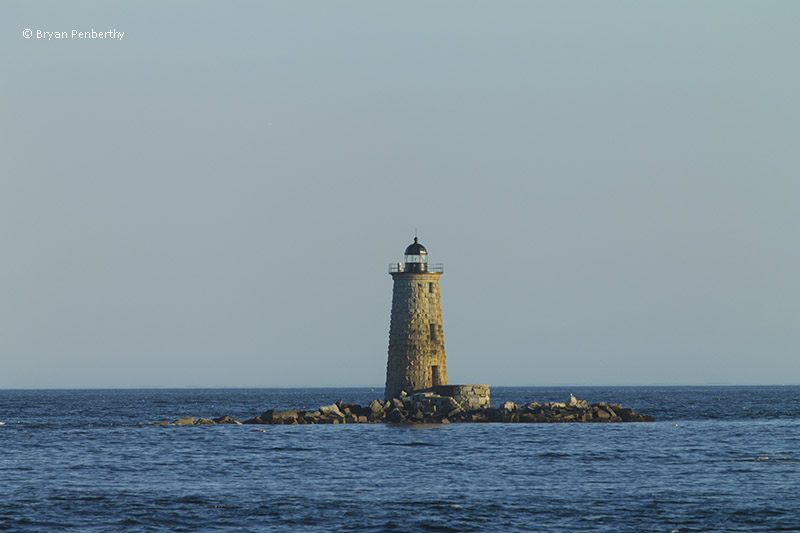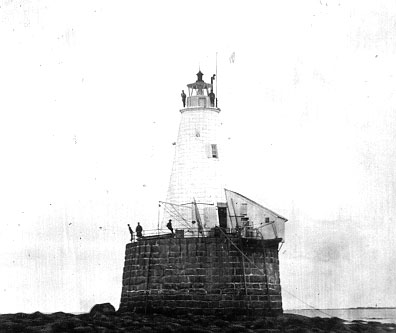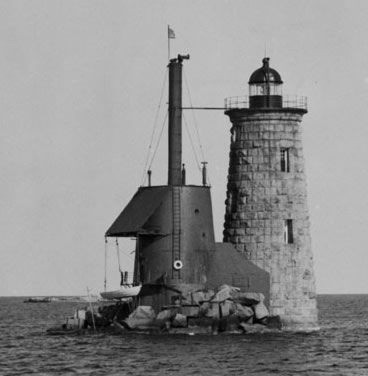Whaleback Lighthouse
Kittery, Maine - 1872 (1830**)

History of the Whaleback Lighthouse
Posted/Updated by Bryan Penberthy on 2016-09-06.
Settling in Portsmouth started in the 1600s due to its natural harbor. With dense forests surrounding the Piscataqua River, Portsmouth would soon be an important port for shipbuilding before the American Revolution and in 1800, the first federal shipyard in the United States was established in Kittery, Maine, just across the Piscataqua River from Portsmouth.
Whaleback Reef is rock formation, submerged at high tide, which stands on the northeast side of the entrance to the Piscataqua River. One of the earliest recorded shipwrecks happened in 1733. Since that time, many other wrecks occurred, prompting the Portsmouth Journal in 1828 to ask "How many more wrecks must be made before Congress will make an appropriation for this object [lighthouse]?"
At that time, Congress had already made an appropriation for a lighthouse on Whaleback Reef a year earlier, in March 1827. However, the appropriation of $1,500 was not nearly enough to erect a lighthouse on a rocky ledge in the Atlantic Ocean, so no action was taken.
New Hampshire Representative Ichabod Bartlett continued to pressure Congress, leading to two additional appropriations being made in 1829. As $20,000 was now allocated for the Whaleback Lighthouse, construction could start.
Nearby Wood Island was used as a staging area for supplies. Due to the exposed location, initial work on the granite pier could only be carried out for a few hours, during low tide. The pier's diameter at the base was 42 feet, tapering to 32 feet at the top. Atop the granite pier was a 38-foot with a 22-foot diameter base, which tapered to 11 feet at the top.
The contractors for the Whaleback Lighthouse were William Palmer and Daniel Haselton. Less than a decade later, Haselton would go on to build the 66-foot tall Robbins Reef Lighthouse in New York Harbor.
 Original Whaleback Lighthouse (Courtesy Coast Guard)
Original Whaleback Lighthouse (Courtesy Coast Guard)
As the keeper was to live at the lighthouse, the tower featured four rooms of living space on two levels, a storage shed, and a cellar. The first keeper appointed to the lighthouse was Samuel E. Hascall with a $500 per year salary.
As there were other lights in the region, notably from the nearby Portsmouth Harbor Lighthouse and others, a plan was devised to differentiate this light from the others. As rotating mechanisms were still being developed, the Whaleback Lighthouse would display two fixed white lights.
The two lights would be vertical, one ten feet above the other. The main light would be 58 feet above mean high water in an octagonal wrought-iron lantern atop the tower. The second light would be shown ten feet below that. Both lights were displayed for the first time on the night of September 16, 1830.
From the beginning, it was clear that the tower was poorly built, leaking badly in heavy seas. After the site was surveyed by Winslow Lewis, a contractor who had built many lighthouses, and Calvin Knowlton, a mason, it was determined that the site hadn't been properly leveled before construction. Instead, small stones were used to fill in the gaps near the bottom. The pair recommended a breakwater be built on the eastern side of the tower at a cost of $20,000, which would protect the foundation.
At some point, the tower was sheathed in wood, which helped with the leaks, but Keeper Hascall still complained that the tower shook during heavy seas and storms. During one particular storm on July 7, 1837, Hascall reported that "articles of furniture were displaced by the motion of the tower." Congress appropriated $3,000 for the breakwater later that year.
As Lewis and Knowleton provided no specific plan for the breakwater, the local lighthouse superintendent, Daniel P. Browne, called upon Alexander Parris, a famed architect and engineer. Parris noted that the lighthouse had been "constructed without science or workmanship," and recommended against erecting a breakwall, stating that it would do very little to protect the tower.
Parris instead recommended a significant masonry tower similar to those employed in the wave-swept British Isles and advised that one could be built for $75,000. Other than general repairs, no action was taken. Neither a breakwall, nor a new lighthouse were ever built. Colonel Thayer, a military architect, had agreed with Parris's assessment and recommended the tower be replaced.
Because of the tower's movement, keepers came and went pretty regularly. One such keeper, Joseph Currier, was on duty in September 1841 when a storm struck. The Portsmouth Journal reported that the tower "rocked like a cradle" and that the keeper "expected every moment that it would be carried away." Although he had only served a few months, Currier resigned shortly after the storm.
Even Stephan Pleasonton, a notorious penny-pincher in charge of the nation's lighthouses, had recommended the Whaleback Lighthouse be replaced in 1838. He recommended a granite tower, similar in design to the Saddleback Ledge Lighthouse, which was under construction at that time. Pleasonton ended his letter with the following, "I am in daily expectation of information that the present building has been demolished by the force of the sea."
I.W.P. Lewis, a civil engineer by trade and the nephew Winslow Lewis, was always a harsh critic of the nation's early lighthouses. In 1843, he visited lighthouses along the eastern seaboard to report on their status to Congress. For the Whaleback Lighthouse, he wrote that he expected that the tower would be "demolished in some severe storm, if not taken down and rebuilt in a proper manner."
Finally, in 1847, Congress appropriated $25,000 to build a new lighthouse. However, for unknown reasons, the old lighthouse was refurbished instead. A report issued in 1850 by the Corps of Topographical Engineers stated that the Whaleback Lighthouse was essentially a harbor light and wasn't worth the expense of a costly granite tower.
The report instead stated that a light tower constructed "upon a suitable iron framing, would cost much less and would answer all purposes." It was suggested that the tower could be erected for $31,000, which was only $6,000 more than the amount appropriated in 1847.
A tower similar in design to the Minot's Ledge Lighthouse in Massachusetts, which was under construction in Massachusetts was proposed. Less than one year after the Minot's Ledge Lighthouse was placed into service, it collapsed during a fierce nor'easter which struck New England on the night of April 16, 1851. The two keepers on duty, Joseph Antione and Joseph Wilson, perished.
In 1852, oversight of the nation's aids to navigation was transferred to the newly established Lighthouse Board. It was made up of engineers and military officials that understood the business. One of their first tasks was to begin outfitting lighthouses with the more efficient Fresnel lens. A fourth-order lens would be installed in the Whaleback Lighthouse in 1855.
In 1867, the tower was repointed and the roof of the woodshed was repaired. The following year, the top of the pier was repointed and two of the iron straps that held the tower to the foundation were rebolted. The entry in the Report of the Secretary of the Treasury stated that the tower leaked badly. The Report of the Secretary of the Treasury on the State of Finances for the Year 1869 had a much more urgent entry:
42. Whalesback - This station is much exposed, and has for some time been in bad condition. It suffered severely from the gales of last winter and spring - particularly in those of March last, which caused cracks in the tower and its foundations. The iron clamps which were intended to secure the stones of the foundation pier are all broken, and the stones on the upper side are cracked and started out. By putting an iron band of six inches by two around the upper course of stone of the pier an attempt has been made to put the station in a condition to last through the coming winter, but there can be no reliance upon this expedient for any length of time, and there is no doubt but the station should be rebuilt as soon as possible, for which purpose the sum of seventy-five thousand dollars is included in the estimates accompanying this report.
On July 15, 1870, Congress had finally appropriated $70,000 for a granite lighthouse at Whaleback Ledge. That same year, the surface of the ledge was being prepared and leveled for the new tower, steps that weren't taken when the first tower was built.
With the exception of low tide, the site was under water and open to the full force of the Atlantic Ocean. Due to the exposed location, work on the new tower, which was being erected on the ledge adjacent to the old tower, was slow to progress.
Plans called for a masonry tower constructed of granite blocks dovetailed together, a design that is similar to other granite towers, such as the 1860 Minot's Ledge Lighthouse and the Eddystone Lighthouse in England. The new tower was to be solid to a height of 20 feet above low water mark, have a base diameter of 27 feet, and a focal plane of 59 feet.
By August 1871, the last granite block was laid. Installation of the lantern and other iron work soon followed, which allowed the lighting apparatus to be installed. Inside, the tower was lined with brick and had hard pine floors. Each of the four floors was supported by horizontal I-beams and were connected by cast-iron staircases.
When completed, the fourth-order Fresnel lens was moved over to the new tower. The light was first displayed in 1872, with William H. Caswell serving as principal keeper, and his son, Frank, serving as assistant.
By 1877, there were many complaints that the fog bell couldn't be heard in heavy weather. Later that year, the 1830 tower was converted to a fog signal building and a third-class Daboll trumpet, operated by duplicate caloric engines, was installed.
As the old 1830 tower was still in poor condition and access was dangerous, Congress appropriated $15,000 on April 30, 1878 for the repairs necessary for the safety and continuance of the fog signal. By that summer, a new cast-iron tower, half the height of the new tower, was constructed just north of the lighthouse. A cast-iron pipe surmounted the fog signal building, providing a high vantage point for the trumpet.
By fall, the fog signal equipment was moved to the new building and operational; providing an eight-second blast every 30 seconds. The following year, the 1830 tower was torn down to provide a safe place for the keeper's boat.
In 1881, a covered way was constructed between the tower and the fog signal building. The following year, while the fog signal building was being painted, assistant keeper John Lewis fell from the area near the top of the iron pipe. He was transported to shore, but died from his injuries a few days later at his home in Kittery, Maine.
Once the 1830 lighthouse was taken down, the pier on which it stood provided protection for the funnel-like opening between the new tower and fog signal building. However, by 1886, the mighty Atlantic Ocean was wearing away at it.
By 1886, many of the large stones had been torn away. After a storm in March of 1888, very little was left. To provide protection a protective bulkhead was built:
A bulkhead 20 feet in height was built of heavy pine timbers and planking, carefully scribed and heavily bolted to both towers and to the ledge, after a tedious excavation of 4 feet through concrete at the lowest stages of the tide, and after the space between the bulkhead and towers had been compactly filled with dry masonry from the demolished base.
The work was nearly complete when a storm in November of 1888 tore away several more courses of the stone foundation and swept away a derrick that was being used to construct the bulkhead. The storm also cut away gravel on one side of the fog signal building to a depth of one-foot below the iron plates and removed some concrete in the lower section.
The storm left 1,500 to 2,000 tons of granite stones piled around the lighthouse, which made access tedious. As the removal of the stones from such an exposed location would have been costly, instead, they were broken down, shifted, and packed to create a boat slip. Some of the stones were used to cover the exposed section of the fog signal building, which were set in concrete.
The characteristic of the fog horn was changed on April 30, 1896, to a 3-second blast, followed by 17-seconds of silence. In 1899, a 1¼ horsepower Hornsby-Akroyd oil engine and Clayton air compressor were installed, replacing the worn out caloric engine. The characteristic of the fog signal was changed again on May 29, 1899.
In 1900, a duplicate set of equipment was installed for redundancy and the following year, four large air tanks were installed to increase the air-storage capacity. The oil engines were upgraded again in 1902 to 4-horsepower horizontal oil engines. Also at that time, a first-class Daboll trumpet was installed.
One of the longest serving keepers was Walter S. Amee. He took over the principal keeper position in 1893 and remained in charge until 1921. During his tenure, he had been credited for several daring rescues.
 Whaleback Light circa 1950 (Courtesy Coast Guard)
Whaleback Light circa 1950 (Courtesy Coast Guard)
During a storm in August of 1899, a small boat capsized near the tower. Hearing the cries for help, the assistant keeper repeatedly blasted the foghorn to try to get the attention of the nearby lifesaving station. Rather than wait, Keeper Amee launched the station's boat and plucked the men from the water.
Another instance occurred in July of 1911. Two young men in a powerboat were entering the Piscataqua River when they hit a rock. Their boat quickly started taking on water. Hearing their cries for help, Keeper Amee was able to launch the station's boat and rescue the men from the sinking vessel.
In 1912, the fourth-order Fresnel lens installed in 1898 was replaced with a new fourth-order Fresnel lens manufactured by Barbier, Bernard, and Turenne of Paris, France. Also at that time, the lamp was replaced with a new incandescent oil vapor (IOV) lamp.
The Coast Guard took over operation of all the nation's lighthouses in 1939. At that time, a new, more powerful foghorn was installed, which startled locals prompting them to call the Portsmouth Police inquiring about the "groaning noise." Soon thereafter, the station was converted to electricity.
The station was automated in January of 1963. At that time, the fourth-order Fresnel lens was replaced by rotating aerobeacons, a change which enhanced its illumination from 50,000 to 3.5 million candlepower. At the time of automation, the cast-iron fog signal building was razed.
The aerobeacons were replaced with a smaller VRB-25 optic in 2002, which was replaced again in 2009 with a solar-powered VLB-44 LED optic. Today, the 1912 fourth-order Fresnel lens is in storage at the Peabody Essex Museum in Salem, Massachusetts.
In 2007, the Coast Guard had deemed the Whaleback Lighthouse excess. On June 18, 2007, the General Services Administration of the U.S. Government filed a Notice of Availability stating that the Whaleback Lighthouse was being made available at no cost through the National Historic Lighthouse Preservation Act.
The act makes excess lighthouses available to nonprofit agencies, state and local governments, and educational institutions at no cost, provided the entity maintains the light and makes it available to the public.
In November 2008, it was announced that the American Lighthouse Foundation's (ALF) application was accepted. Today, the Whaleback Lighthouse is managed by the Friends of Portsmouth Harbor Lighthouse, a chapter of the American Lighthouse Foundation.
Reference:
- The Lighthouses of Maine: Southern Maine and Casco Bay, Jeremy D'Entremont, 2013.
- Annual Report of the Light House Board, U.S. Lighthouse Service, Various years.
- http://www.portsmouthharborlighthouse.org/ website.
Directions: The lighthouse sits in the Atlantic Ocean, at the entrance to the Piscataqua River. The best views are from the water via one of the several tour companies that leave out of Portsmouth Harbor.
If a boat tour isn't for you, there are many locations onshore where the Whaleback Lighthouse can been seen. One of the best spots is Fort Foster Park in Kittery, Maine. Other locations include Fort Constitution, Fort Stark, and Great Island Common in New Castle, New Hampshire, to name a few.
Access: The lighthouse is owned and managed by the Friends of Portsmouth Harbor Lighthouses, a chapter of the American Lighthouse Foundation (ALF).
View more Whaleback Lighthouse picturesTower Height: 50.00'
Focal Plane: 59'
Active Aid to Navigation: Yes
*Latitude: 43.05878 N
*Longitude: -70.69630 W
See this lighthouse on Google Maps.
